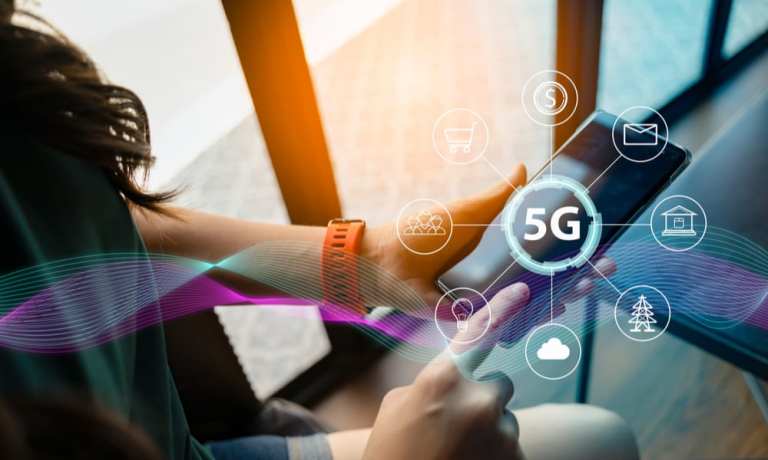
On the other side of the pandemic — whenever that might be — might 5G and a new age of connectivity await?
As Amy McCune, VP & COO of Ericsson North America, told Karen Webster in a recent interview, the shifts in the way we live, work, spend leisure time and even get healthcare delivered are proving to be tailwinds for the next generation of wireless communications technologies.
Operators in general across the U.S., she said, are continuing with their 5G plans, off of some building blocks laid last year.
“We started off at the end of 2019 with about 13 million subscriptions across the globe,” she told Webster. “We saw the introduction of some high-end smartphones” and coverage increased across a number of major U.S. cities. Ericsson, she said, has presence across 27 live 5G networks.
Beyond those high-level data points, there are now some headwinds to 5G deployments – not the least of which is the uncertain business investment climate wrought by the coronavirus. There’s an infrastructure challenge, too.
McCune noted that at the moment, there are 300,000 cellular sites across the United States, and that tally has to reach one million for wide 5G coverage – across street poles, sides of buildings and even traffic lights.
Then there’s the challenge on the ground, so to speak, in getting that infrastructure in place. She said that local government restrictions are currently hindering those deployments.
“As cities get their arms around what a smart city could do for them, their appetite to move more quickly will change,” McCune predicted. Another tailwind might be seen as the current pandemic spotlights the limitations of 3G and 4G networks.
Recent legislation may pave the way for greater access to sites and to spectrum. As noted in this space late last month, President Donald Trump signed two bills into law that seek to improve broadband connectivity across the U.S. through the Secure 5G and Beyond Act and the Broadband Deployment Accuracy and Technological Availability Act.
But none of those challenges will prove insurmountable, because the simple fact is that the very fabric of changed daily life demands greater connectivity.
Overall, said McCune, “we see 2020 is going to be the year when we see major momentum,” where there will likely be 100 million subscriptions – not just driven by smartphones, but also other devices. An increasing percentage of the population is also able to afford 5G devices, she noted.
The Stay-at-Home Spike
The groundwork is being laid for an explosion in 5G adoption – especially in the current situation. COVID-19 is spotlighting data inequality, where swaths of the U.S. population across certain geographies and financial situations do not have the access to technologies or networks that allow them to do school work through distance learning.
Drilling down into the immediate impacts of stay-at-home and work-from-home mandates, McCune told Wesbster, “there are different needs being put on the network. We’re actually seeing more voice usage than we have seen in some time.”
She noted that there have been some instances of lower data usage across networks during the day, because so many people have been relying on Wi-Fi.
“We’re seeing the constraints of Wi-Fi,” McCune said, “and not just the constraints from a capability perspective, but from a security perspective as well.” That comes as neighbors might be “piggybacking” on one another’s Wi-Fi setups.
The shift to doing everything from home also spotlights the benefits of cellular technology, and 5G in particular, said McCune. Right now, 5G is finding its low-hanging fruit in mission-critical industries such as finance and healthcare, among others (even mining), where speed of data and low latency – along with secure transmission of data – are necessary for these sectors to do their jobs.
5G also enables “network slicing,” which means multiple “networks” can be created on top of the existing infrastructure, allowing individual verticals (utilities, for example, or manufacturing firms that deploy robots) to communicate across their ecosystems and serve business needs.
Enterprises will be able to increase their own business capabilities and operators will be able to monetize their own 5G investments more quickly. McCune cited existing initiatives between Ericsson and Maersk as examples of proof points to spur continued investments in 5G.
“There is definitely an ecosystem that has to come to life in order to reap the biggest benefits possible with 5G,” she said. Automation and machine learning, along with artificial intelligence (AI), can help operators run their networks more efficiently to ultimately provide a better customer experience.
The Consumer Benefits
As to those larger benefits…
…we are likely headed to a consumer experience across gaming, commerce and media that will see the absence of the “spinning dial.”
You know the one: The icon that shows movies or other content are downloading for what seems an interminable length of time. McCune told Webster that the shift from 4G to 5G has a remarkable improvement in latency. For example, movies can be downloaded to devices in seconds rather than minutes, opening up a huge opportunity for new apps and new avenues of streaming content and revenues over time.
“That’s what consumers are going to get accustomed to,” said McCune.